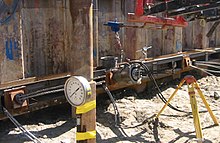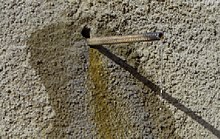Anchor (geotechnical engineering)
In geotechnical engineering , an anchor is a component that introduces tensile forces into the ground or rock .
Anchors or nails are drilled or rammed into the ground as tension members
anchoring
- Wedging, spreading
- At the lowest point of the anchor, mechanical wedging or expansion is carried out using wedges or threads. One then speaks of a wedge or expansion anchor or nail. These are mainly used in rock construction ( tunnel construction ).
- Bonding
- An adhesive cartridge with separate fractions of a two-component adhesive is inserted into the borehole and pierced with the anchor rod. The components mix and harden. Adhesive anchors are mainly used in rock construction . In structural and civil engineering, they are also used for anchoring in existing concrete components. In bridge building they come e.g. B. to attach the edge beams or railings are used.
- Grouting
- After the anchor steel has been drilled in, anchor mortar ( synthetic resin or cement mortar ) is pressed into the depth of the borehole until it emerges again at the borehole opening. Grouted anchors are also called grout anchors . The anchor can also be prestressed after hardening.
Useful life
Temporary anchors are approved for use for up to two years.
Semi-permanent tankers are designed to be used for up to 4 years. In Germany they are not regulated and can only be used with an authorization in individual cases.
Permanent anchors are intended for permanent use. In the case of safety-relevant operations, measuring systems are provided for monitoring.
The design of the anchor systems mainly only differs in the durability of the corrosion protection .
Load entry
In the case of slack anchors, the elongation of the anchor and, if applicable, the deformation of the subsurface depends on the load. The resulting resilience of the anchorage can be a disadvantage for some applications.
Prestressed anchors are prestressed with a specified force after the anchor mortar has hardened. Spread and wedged anchors usually require permanent pre-tensioning anyway. Settlement phenomena and the elastic deformation of the anchorage are anticipated by the prestressing . With a load up to the level of the prestressing, no further flexibility of the anchoring is to be expected.
In the case of longer rod and strand anchors, it is often an advantage if the force is only applied to solid ground areas at the end of the anchor or in deep rock. In order to prevent the application of force in the remaining length of the anchor, a so-called free play section can be provided between the anchor head and anchoring section by sliding smooth plastic tubes over the anchor steel during installation.
monitoring
In the case of permanent anchors, special attention must be paid to maintaining the function. Depending on the structure and type of anchor, different tests can be planned:
- Continuous force measurements
- The expansion of the anchor is monitored by means of special pressure cells.
- Spontaneous force measurement
- An anchor press is used to check the holding force of the anchor at larger intervals.
- Corrosion measurement
- The risk of corrosion of the anchor can be continuously monitored by measuring the potential using an electrode ( CMS electrode ) that is introduced when the anchor is installed . If the measurement shows no corrosion, the anchor is completely safe.
Ground and rock nails
Self-drilling anchors are also referred to as rock nails. The tip of the anchor rod is provided with a drill bit which, depending on the nature of the subsoil, allows the anchor to be driven by rotating or percussion drilling. The drill bit usually remains in the ground as a lost tip.
With these nails, forces of up to approx. 1000 kN can be introduced into the ground. Usually the nails are pipes so that the anchor mortar can be pressed through the anchor into the borehole.
In order to determine the average service life of soil nails, the so-called corrosion rate to be expected is estimated.
Rod anchor
Rod anchors consist of steel rods with a diameter of 20 to 65 mm and a length of up to 16 m in various steel grades. The rods can also be extended by means of sleeves (coupling pieces).
Normally, a hole is first made in the subsoil, which is optionally lined with a pipe. The rod anchor is introduced. Cement mortar is injected while the drill pipe is being pulled.
Strand anchor
7 steel wires made of high-strength steel are woven into a strand. Commercially available strands have a diameter of 0.6 or 0.62 inches , i.e. about 15¼ or 15¾ mm. The number of strands is determined depending on the force required. Usually 3 to a maximum of 22 strands are used per anchor. The length of the strand anchor is arbitrary.
Normally, holes are drilled into the subsoil for the strand anchors, the strand anchor is inserted and then grouted with cement mortar. Depending on the stability of the soil, the drilling is either cased (sand, gravel) or uncased (solid rock, rock). In the case of a cased bore, the pipe is pulled during the grouting.
Medium load tanker
An anchor in the ground or rock that can absorb a tensile force of 2 kN to 40 kN (200 kg to 4 t). In terms of force, this lies between the usual dowels (e.g. Fischer, Upat, Hilti etc.) and the anchors that are drilled and mortared into the ground.
Medium-load anchors are usually designed as expansion anchors that are rammed or drilled into the subsoil.
After use, the medium-load anchor can usually be removed from the ground without leaving any residue. Some species can be used repeatedly. The expansion body may have to be replaced.
Special anchor
- Drainage anchor
- The borehole for drainage anchors is created with a slope so that the water can drain out of the subsoil without pressure. The anchor is grouted with a special single-grain mortar, which does not seal the borehole but allows waterlogging to pass through the spaces between the aggregate used .
- Spinning anchor
- Usually 6 to 12 ribbed rods are hammered into the ground at different angles through the anchor plate. By spreading the anchor rods to each other, tensile, compressive and horizontal forces can be diverted. Since the bars are not mortared, they can simply be pulled out of the ground after use and used again.
- Helix anchor
- The anchor tube has one or more helices at its tip, which screw when drilling into the ground.
Individual evidence
- ↑ corrosion rate in soil nails; GZ. BMVIT-327.120 / 0022-II / ST2 / 2006
- ↑ medium-load anchor from STUBAI (pdf); Archive link ( Memento of the original from October 15, 2013 in the Internet Archive ) Info: The archive link was inserted automatically and has not yet been checked. Please check the original and archive link according to the instructions and then remove this notice. (PDF; 7.1 MB)
- ↑ Medium load anchor from STUBAI (video); [1]









